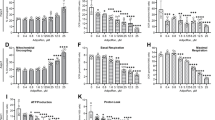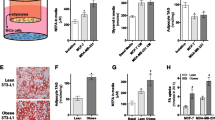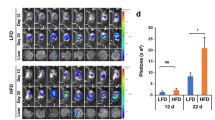Abstract
Obesity and diabetes are both associated risk factors for developing breast cancer and poor patient outcomes. Adipose cells are an important endocrine system and are the main producer of adiponectin, with lean patients having higher circulating levels. Patients with diabetes are often treated with thiazolidinediones, glitazones, which also increase adiponectin production. Importantly high circulating levels of adiponectin and treatment with glitazone are associated with increased breast cancer patient survival. This study investigates the potential of using adipose tissue laden with glitazones to act as a drug depot, increase adiponectin levels, and locally release glitazones to inhibit breast cancer cell proliferation. The breast cancer cell lines MCF-7 and MBA-MD-231, and the normal breast epithelial cell line MCF-10A were exposed to media containing a range of concentrations of recombinant adiponectin, pioglitazone, or conditioned media obtained from pioglitazone laden adipose tissue to determine the impact of the different treatments on cell proliferation. The MCF-7 cells demonstrated the greatest reduction in proliferation upon exposure to adiponectin and pioglitazone with lower reductions observed in the MDA-MD-231 and MCF-10a cell lines. All three cell lines exhibited reductions in proliferation in the presence of pioglitazone loaded adipose tissue. Additionally, adiponectin and pioglitazone levels were higher in the media from glitazone loaded adipose tissue. Drug loaded adipose tissue could potentially be used to deliver adiponectin and glitazone to breast cancer cells and inhibit proliferation. Future research will examine the potential efficacy of this treatment approach in vivo.





Similar content being viewed by others
References
Dalamaga M, Diakopoulos KN, Mantzoros CS (2012) The role of adiponectin in cancer: a review of current evidence. Endocr Rev 33(4):547–594. https://doi.org/10.1210/er.2011-1015
Duggan C, Irwin ML, Xiao L, Henderson KD, Smith AW, Baumgartner RN, Baumgartner KB, Bernstein L, Ballard-Barbash R, McTiernan A (2011) Associations of insulin resistance and adiponectin with mortality in women with breast cancer. J Clin Oncol 29(1):32–39. https://doi.org/10.1200/JCO.2009.26.4473
Hou WK, Xu YX, Yu T, Zhang L, Zhang WW, Fu CL, Sun Y, Wu Q, Chen L (2007) Adipocytokines and breast cancer risk. Chin Med J (Engl) 120(18):1592–1596
Ewertz M, Jensen MB, Gunnarsdottir KA, Hojris I, Jakobsen EH, Nielsen D, Stenbygaard LE, Tange UB, Cold S (2011) Effect of obesity on prognosis after early-stage breast cancer. J Clin Oncol 29(1):25–31. https://doi.org/10.1200/JCO.2010.29.7614
Loi S, Milne RL, Friedlander ML, McCredie MR, Giles GG, Hopper JL, Phillips KA (2005) Obesity and outcomes in premenopausal and postmenopausal breast cancer. Cancer Epidemiol Biomark Prev 14(7):1686–1691. https://doi.org/10.1158/1055-9965.EPI-05-0042
Protani M, Coory M, Martin JH (2010) Effect of obesity on survival of women with breast cancer: systematic review and meta-analysis. Breast Cancer Res Treat 123(3):627–635. https://doi.org/10.1007/s10549-010-0990-0
Chandran M, Phillips SA, Ciaraldi T, Henry RR (2003) Adiponectin: more than just another fat cell hormone? Diabetes Care 26(8):2442–2450
Kern PA, Di Gregorio GB, Lu T, Rassouli N, Ranganathan G (2003) Adiponectin expression from human adipose tissue: relation to obesity, insulin resistance, and tumor necrosis factor-alpha expression. Diabetes 52(7):1779–1785
Kubota N, Terauchi Y, Yamauchi T, Kubota T, Moroi M, Matsui J, Eto K, Yamashita T, Kamon J, Satoh H, Yano W, Froguel P, Nagai R, Kimura S, Kadowaki T, Noda T (2002) Disruption of adiponectin causes insulin resistance and neointimal formation. J Biol Chem 277(29):25863–25866. https://doi.org/10.1074/jbc.C200251200
Ouchi N, Kihara S, Funahashi T, Nakamura T, Nishida M, Kumada M, Okamoto Y, Ohashi K, Nagaretani H, Kishida K, Nishizawa H, Maeda N, Kobayashi H, Hiraoka H, Matsuzawa Y (2003) Reciprocal association of C-reactive protein with adiponectin in blood stream and adipose tissue. Circulation 107(5):671–674
Yu JG, Javorschi S, Hevener AL, Kruszynska YT, Norman RA, Sinha M, Olefsky JM (2002) The effect of thiazolidinediones on plasma adiponectin levels in normal, obese, and type 2 diabetic subjects. Diabetes 51(10):2968–2974
Ouchi N, Walsh K (2007) Adiponectin as an anti-inflammatory factor. Clin Chim Acta 380(1–2):24–30. https://doi.org/10.1016/j.cca.2007.01.026
Guo MM, Duan XN, Cui SD, Tian FG, Cao XC, Geng CZ, Fan ZM, Wang X, Wang S, Jiang HC, Zhang JG, Jin F, Tang JH, Liang H, Yang ZL, Wang HB, Wang QT, Li GL, Li L, Zhu SG, Zuo WS, Liu LY, Wang L, Ma DD, Liu SC, Xiang YJ, Liu L, Ye CM, Zhou WZ, Wang F, Yu LX, Ma ZB, Yu ZG (2015) Circulating high-molecular-weight (hmw) adiponectin level is related with breast cancer risk better than total adiponectin: a case-control study. PLoS ONE 10(6):e0129246. https://doi.org/10.1371/journal.pone.0129246
Korner A, Pazaitou-Panayiotou K, Kelesidis T, Kelesidis I, Williams CJ, Kaprara A, Bullen J, Neuwirth A, Tseleni S, Mitsiades N, Kiess W, Mantzoros CS (2007) Total and high-molecular-weight adiponectin in breast cancer: in vitro and in vivo studies. J Clin Endocrinol Metab 92(3):1041–1048. https://doi.org/10.1210/jc.2006-1858
Taliaferro-Smith L, Nagalingam A, Knight BB, Oberlick E, Saxena NK, Sharma D (2013) Integral role of PTP1B in adiponectin-mediated inhibition of oncogenic actions of leptin in breast carcinogenesis. Neoplasia 15(1):23–38
Wang Y, Lam JB, Lam KS, Liu J, Lam MC, Hoo RL, Wu D, Cooper GJ, Xu A (2006) Adiponectin modulates the glycogen synthase kinase-3beta/beta-catenin signaling pathway and attenuates mammary tumorigenesis of MDA-MB-231 cells in nude mice. Can Res 66(23):11462–11470. https://doi.org/10.1158/0008-5472.CAN-06-1969
Lam JB, Chow KH, Xu A, Lam KS, Liu J, Wong NS, Moon RT, Shepherd PR, Cooper GJ, Wang Y (2009) Adiponectin haploinsufficiency promotes mammary tumor development in MMTV-PyVT mice by modulation of phosphatase and tensin homolog activities. PLoS ONE 4(3):e4968. https://doi.org/10.1371/journal.pone.0004968
Sun Y, Lodish HF (2010) Adiponectin deficiency promotes tumor growth in mice by reducing macrophage infiltration. PLoS ONE 5(8):e11987. https://doi.org/10.1371/journal.pone.0011987
Saxena NK, Sharma D (2010) Metastasis suppression by adiponectin: LKB1 rises up to the challenge. Cell Adhes Migr 4(3):358–362
Taliaferro-Smith L, Nagalingam A, Zhong D, Zhou W, Saxena NK, Sharma D (2009) LKB1 is required for adiponectin-mediated modulation of AMPK-S6 K axis and inhibition of migration and invasion of breast cancer cells. Oncogene 28(29):2621–2633. https://doi.org/10.1038/onc.2009.129
Denzel MS, Hebbard LW, Shostak G, Shapiro L, Cardiff RD, Ranscht B (2009) Adiponectin deficiency limits tumor vascularization in the MMTV-PyV-mT mouse model of mammary cancer. Clin Cancer Res 15(10):3256–3264. https://doi.org/10.1158/1078-0432.CCR-08-2661
Man K, Ng KT, Xu A, Cheng Q, Lo CM, Xiao JW, Sun BS, Lim ZX, Cheung JS, Wu EX, Sun CK, Poon RT, Fan ST (2010) Suppression of liver tumor growth and metastasis by adiponectin in nude mice through inhibition of tumor angiogenesis and downregulation of Rho kinase/IFN-inducible protein 10/matrix metalloproteinase 9 signaling. Clin Cancer Res 16(3):967–977. https://doi.org/10.1158/1078-0432.CCR-09-1487
Ruan H, Dong LQ (2016) Adiponectin signaling and function in insulin target tissues. J Mol Cell Biol 8(2):101–109. https://doi.org/10.1093/jmcb/mjw014
Nanjan MJ, Mohammed M, Prashantha Kumar BR, Chandrasekar MJN (2018) Thiazolidinediones as antidiabetic agents: a critical review. Bioorg Chem 77:548–567. https://doi.org/10.1016/j.bioorg.2018.02.009
Kim SG, Ryu OH, Kim HY, Lee KW, Seo JA, Kim NH, Choi KM, Lee J, Baik SH, Choi DS (2006) Effect of rosiglitazone on plasma adiponectin levels and arterial stiffness in subjects with prediabetes or non-diabetic metabolic syndrome. Eur J Endocrinol 154(3):433–440. https://doi.org/10.1530/eje.1.02100
Majuri A, Santaniemi M, Rautio K, Kunnari A, Vartiainen J, Ruokonen A, Kesaniemi YA, Tapanainen JS, Ukkola O, Morin-Papunen L (2007) Rosiglitazone treatment increases plasma levels of adiponectin and decreases levels of resistin in overweight women with PCOS: a randomized placebo-controlled study. Eur J Endocrinol 156(2):263–269. https://doi.org/10.1530/eje.1.02331
Iwaki M, Matsuda M, Maeda N, Funahashi T, Matsuzawa Y, Makishima M, Shimomura I (2003) Induction of adiponectin, a fat-derived antidiabetic and antiatherogenic factor, by nuclear receptors. Diabetes 52(7):1655–1663
Matsuda M, Shimomura I (2014) Roles of oxidative stress, adiponectin, and nuclear hormone receptors in obesity-associated insulin resistance and cardiovascular risk. Horm Mol Biol Clin Investig 19(2):75–88. https://doi.org/10.1515/hmbci-2014-0001
Phillips SA, Kung J, Ciaraldi TP, Choe C, Christiansen L, Mudaliar S, Henry RR (2009) Selective regulation of cellular and secreted multimeric adiponectin by antidiabetic therapies in humans. Am J Physiol Endocrinol Metab 297(3):E767–E773. https://doi.org/10.1152/ajpendo.00378.2009
Cariou B, Charbonnel B, Staels B (2012) Thiazolidinediones and PPARgamma agonists: time for a reassessment. Trends Endocrinol Metab 23(5):205–215. https://doi.org/10.1016/j.tem.2012.03.001
Elstner E, Muller C, Koshizuka K, Williamson EA, Park D, Asou H, Shintaku P, Said JW, Heber D, Koeffler HP (1998) Ligands for peroxisome proliferator-activated receptorgamma and retinoic acid receptor inhibit growth and induce apoptosis of human breast cancer cells in vitro and in BNX mice. Proc Natl Acad Sci USA 95(15):8806–8811
Grommes C, Landreth GE, Heneka MT (2004) Antineoplastic effects of peroxisome proliferator-activated receptor gamma agonists. Lancet Oncol 5(7):419–429. https://doi.org/10.1016/S1470-2045(04)01509-8
Skelhorne-Gross G, Reid AL, Apostoli AJ, Di Lena MA, Rubino RE, Peterson NT, Schneider M, SenGupta SK, Gonzalez FJ, Nicol CJ (2012) Stromal adipocyte PPARgamma protects against breast tumorigenesis. Carcinogenesis 33(7):1412–1420. https://doi.org/10.1093/carcin/bgs173
Du R, Lin L, Cheng D, Xu Y, Xu M, Chen Y, Wang W, Bi Y, Li D, Lu J (2018) Thiazolidinedione therapy and breast cancer risk in diabetic women: a systematic review and meta-analysis. Diabetes Metab Res Rev. https://doi.org/10.1002/dmrr.2961
He X, Esteva FJ, Ensor J, Hortobagyi GN, Lee MH, Yeung SC (2012) Metformin and thiazolidinediones are associated with improved breast cancer-specific survival of diabetic women with HER2+ breast cancer. Ann Oncol 23(7):1771–1780. https://doi.org/10.1093/annonc/mdr534
Cao JQ, Olson RA, Tyldesley SK (2013) Comparison of recurrence and survival rates after breast-conserving therapy and mastectomy in young women with breast cancer. Curr Oncol 20(6):e593–e601. https://doi.org/10.3747/co.20.1543
Fisher B, Anderson S, Bryant J, Margolese RG, Deutsch M, Fisher ER, Jeong JH, Wolmark N (2002) Twenty-year follow-up of a randomized trial comparing total mastectomy, lumpectomy, and lumpectomy plus irradiation for the treatment of invasive breast cancer. N Engl J Med 347(16):1233–1241. https://doi.org/10.1056/NEJMoa022152
Group EBCC, Group ER, Bijker N, Meijnen P, Peterse JL, Bogaerts J, Van Hoorebeeck I, Julien JP, Gennaro M, Rouanet P, Avril A, Fentiman IS, Bartelink H, Rutgers EJ (2006) Breast-conserving treatment with or without radiotherapy in ductal carcinoma-in situ: ten-year results of European Organisation for Research and Treatment of Cancer randomized phase III trial 10853—a study by the EORTC Breast Cancer Cooperative Group and EORTC Radiotherapy Group. J Clin Oncol 24(21):3381–3387. https://doi.org/10.1200/jco.2006.06.1366
Illouz YG, Sterodimas A (2009) Autologous fat transplantation to the breast: a personal technique with 25 years of experience. Aesthetic Plast Surg 33(5):706–715. https://doi.org/10.1007/s00266-009-9377-1
Perez-Cano R, Vranckx JJ, Lasso JM, Calabrese C, Merck B, Milstein AM, Sassoon E, Delay E, Weiler-Mithoff EM (2012) Prospective trial of adipose-derived regenerative cell (ADRC)-enriched fat grafting for partial mastectomy defects: the RESTORE-2 trial. Eur J Surg Oncol 38(5):382–389. https://doi.org/10.1016/j.ejso.2012.02.178
Sanders WG, Li H, Zhuplatov I, He Y, Kim SE, Cheung AK, Agarwal J, Terry CM (2017) Autologous fat transplants to deliver glitazone and adiponectin for vasculoprotection. J Controll Rel 264:237–246. https://doi.org/10.1016/j.jconrel.2017.08.036
Phillips SA, Ciaraldi TP, Oh DK, Savu MK, Henry RR (2008) Adiponectin secretion and response to pioglitazone is depot dependent in cultured human adipose tissue. Am J Physiol Endocrinol Metab 295(4):E842–E850. https://doi.org/10.1152/ajpendo.90359.2008
Lin ZJ, Desai-Krieger D, Shum L (2004) Simultaneous determination of glipizide and rosiglitazone unbound drug concentrations in plasma by equilibrium dialysis and liquid chromatography-tandem mass spectrometry. J Chromatogr B Anal Technol Biomed Life Sci 801(2):265–272
Lin ZJ, Ji W, Desai-Krieger D, Shum L (2003) Simultaneous determination of pioglitazone and its two active metabolites in human plasma by LC-MS/MS. J Pharm Biomed Anal 33(1):101–108
Tian YF, Chu CH, Wu MH, Chang CL, Yang T, Chou YC, Hsu GC, Yu CP, Yu JC, Sun CA (2007) Anthropometric measures, plasma adiponectin, and breast cancer risk. Endocr Relat Cancer 14(3):669–677. https://doi.org/10.1677/ERC-06-0089
Tworoger SS, Eliassen AH, Kelesidis T, Colditz GA, Willett WC, Mantzoros CS, Hankinson SE (2007) Plasma adiponectin concentrations and risk of incident breast cancer. J Clin Endocrinol Metab 92(4):1510–1516. https://doi.org/10.1210/jc.2006-1975
Theriau CF, Sauve OS, Beaudoin MS, Wright DC, Connor MK (2017) Proliferative endocrine effects of adipose tissue from obese animals on MCF7 cells are ameliorated by resveratrol supplementation. PLoS ONE 12(9):e0183897. https://doi.org/10.1371/journal.pone.0183897
Hug C, Wang J, Ahmad NS, Bogan JS, Tsao TS, Lodish HF (2004) T-cadherin is a receptor for hexameric and high-molecular-weight forms of Acrp30/adiponectin. Proc Natl Acad Sci USA 101(28):10308–10313. https://doi.org/10.1073/pnas.0403382101
Philippova M, Pfaff D, Kyriakakis E, Buechner SA, Iezzi G, Spagnoli GC, Schoenenberger AW, Erne P, Resink TJ (2013) T-cadherin loss promotes experimental metastasis of squamous cell carcinoma. Eur J Cancer 49(8):2048–2058. https://doi.org/10.1016/j.ejca.2012.12.026
Westerink J, Visseren FL (2011) Pharmacological and non-pharmacological interventions to influence adipose tissue function. Cardiovasc Diabetol 10(1):13. https://doi.org/10.1186/1475-2840-10-13
Yee LD, Williams N, Wen P, Young DC, Lester J, Johnson MV, Farrar WB, Walker MJ, Povoski SP, Suster S, Eng C (2007) Pilot study of rosiglitazone therapy in women with breast cancer: effects of short-term therapy on tumor tissue and serum markers. Clin Cancer Res 13(1):246–252. https://doi.org/10.1158/1078-0432.CCR-06-1947
Mueller E, Sarraf P, Tontonoz P, Evans RM, Martin KJ, Zhang M, Fletcher C, Singer S, Spiegelman BM (1998) Terminal differentiation of human breast cancer through PPAR gamma. Mol Cell 1(3):465–470
Wang Y, James M, Wen W, Lu Y, Szabo E, Lubet RA, You M (2010) Chemopreventive effects of pioglitazone on chemically induced lung carcinogenesis in mice. Mol Cancer Ther 9(11):3074–3082. https://doi.org/10.1158/1535-7163.MCT-10-0510
Blanquicett C, Roman J, Hart CM (2008) Thiazolidinediones as anti-cancer agents. Cancer Ther 6(1):25–34
Jarrar MH, Baranova A (2007) PPARgamma activation by thiazolidinediones (TZDs) may modulate breast carcinoma outcome: the importance of interplay with TGFbeta signalling. J Cell Mol Med 11(1):71–87. https://doi.org/10.1111/j.1582-4934.2007.00003.x
Nawrocki AR, Rajala MW, Tomas E, Pajvani UB, Saha AK, Trumbauer ME, Pang Z, Chen AS, Ruderman NB, Chen H, Rossetti L, Scherer PE (2006) Mice lacking adiponectin show decreased hepatic insulin sensitivity and reduced responsiveness to peroxisome proliferator-activated receptor gamma agonists. J Biol Chem 281(5):2654–2660. https://doi.org/10.1074/jbc.M505311200
Acknowledgements
This work is funded by the NIH Award Number 1 R21 CA187829-01. The authors would like to thank the Department of Surgery Research Laboratory and the Preclinical Research Resource at Huntsman Cancer Institute for their assistance in this work.
Author information
Authors and Affiliations
Corresponding author
Ethics declarations
Conflict of interest
None of the authors have any relevant conflicts of interest.
Additional information
Publisher's Note
Springer Nature remains neutral with regard to jurisdictional claims in published maps and institutional affiliations.
Rights and permissions
About this article
Cite this article
Shea, J., Terry, C., Edwards, K. et al. Glitazone loaded fat enhances adiponectin production and inhibits breast cancer cell proliferation. Mol Biol Rep 46, 6485–6494 (2019). https://doi.org/10.1007/s11033-019-05094-x
Received:
Accepted:
Published:
Issue Date:
DOI: https://doi.org/10.1007/s11033-019-05094-x




